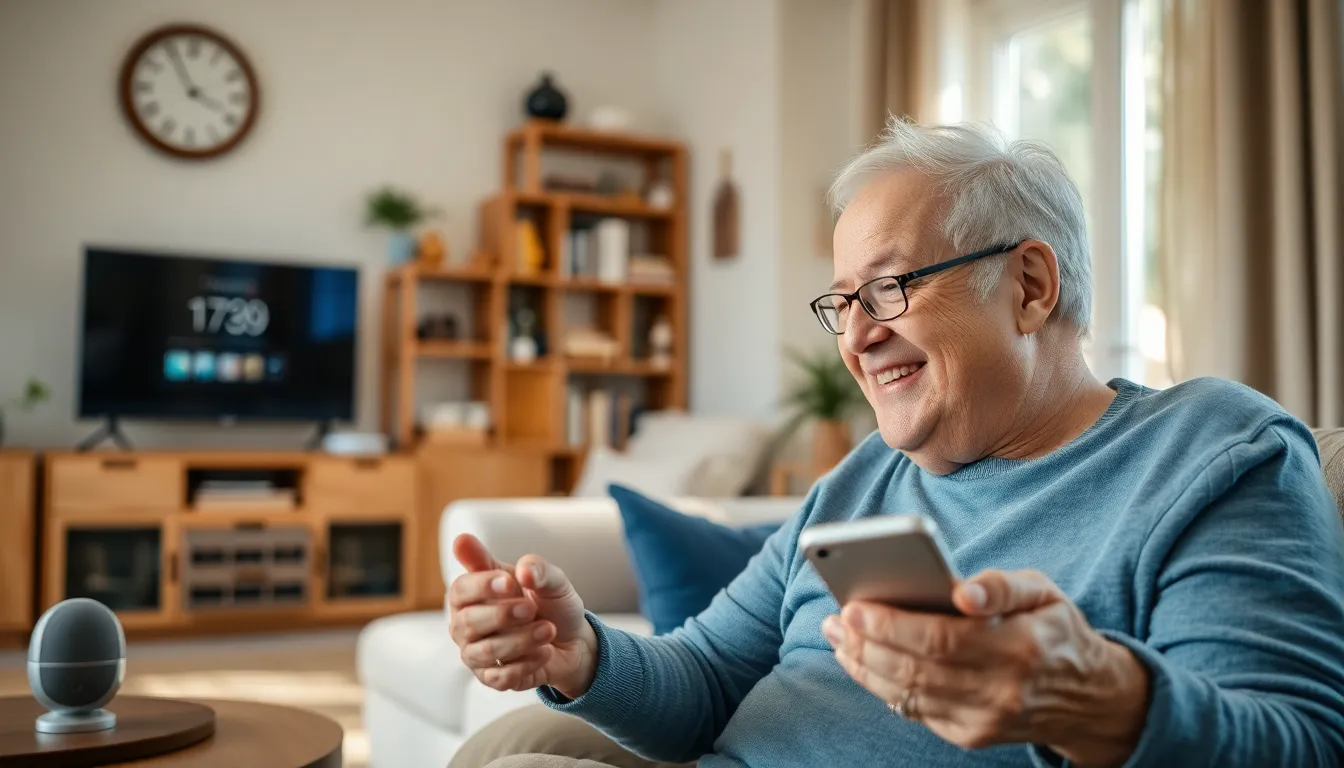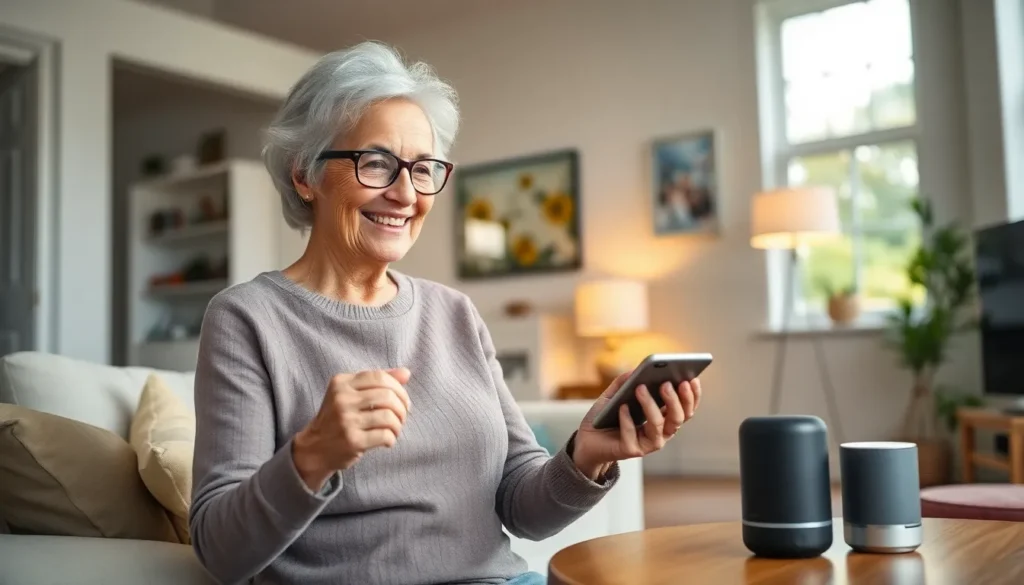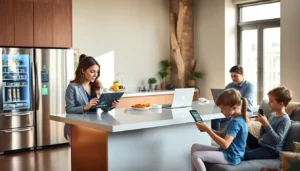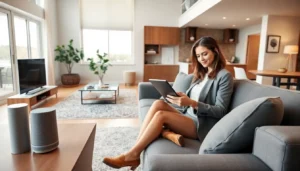As the world zooms ahead with technology, the golden years don’t have to feel like a slow crawl. Imagine a life where seniors can navigate their daily routines with the ease of a seasoned techie. From smart home gadgets that brew coffee on command to wearable devices that monitor health, tech-enabled solutions are transforming the way elderly individuals live independently.
Importance of Tech-Enabled Elderly Independence
Tech-enabled solutions significantly enhance the independence of elderly individuals. These innovations empower seniors to manage their lives efficiently while maintaining their well-being.
Enhancing Quality of Life
Technologies such as smart home devices improve seniors’ daily experiences. Smart thermostat systems regulate temperatures, providing comfort without manual adjustments. Voice-activated assistants simplify tasks like setting reminders or controlling lights. Wearable health monitors track vital signs, ensuring timely medical attention when needed. Telehealth services facilitate easy access to healthcare providers, reducing transportation barriers. Such tools boost confidence by fostering a sense of control over personal surroundings.
Promoting Dignity and Autonomy
Tech tools play a crucial role in preserving the dignity of elderly individuals. Solutions designed for ease of use allow seniors to perform daily activities independently. Accessibility features in devices cater to the unique needs of the elderly, fostering self-sufficiency. Customizable smart home systems enable seniors to tailor their environments to personal preferences. Communication apps facilitate connections with family and friends, mitigating feelings of isolation. These innovations support not only independence, but also the sense of identity and purpose that comes with it.
Innovative Technologies for Seniors

Innovative technologies significantly enhance seniors’ ability to live independently. Smart home devices and wearable health trackers stand out as essential tools for promoting autonomy.
Smart Home Devices
Smart home devices, like smart thermostats and automated lighting, simplify daily tasks for seniors. User-friendly interfaces allow older adults to control their environment easily. Voice-activated assistants, such as Amazon Alexa or Google Assistant, offer hands-free options for managing schedules or making calls. Security systems with remote monitoring ensure safety at home. These technologies foster independence by allowing seniors to customize their living spaces without dependence on caregivers. Enhanced comfort leads to increased confidence in daily life.
Wearable Health Trackers
Wearable health trackers play a vital role in health management for seniors. Devices like Fitbit and Apple Watch monitor heart rates, track physical activity, and remind users to take medications. Real-time data sharing with healthcare providers enhances oversight and timely interventions. Emergency features, such as fall detection, provide peace of mind for both seniors and their families. Engaging with these tech tools helps older adults stay motivated to maintain an active lifestyle. They create a sense of responsibility for personal health, contributing to overall well-being.
Challenges to Adoption
Adopting technology for elderly independence presents several challenges that can hinder its effective use.
Digital Literacy Issues
Many seniors struggle with digital literacy, which directly impacts their ability to use new technologies. Unfamiliarity with devices can lead to frustration, preventing seniors from taking full advantage of tech solutions. Training programs, however, can improve their skills and confidence. Engaging community centers or local organizations helps bridge this gap by offering assistance tailored for elderly individuals. Support from family members also plays a crucial role, as patience and guidance can enhance their comfort. Ultimately, addressing digital literacy is vital for encouraging widespread adoption and empowering seniors with independent living solutions.
Affordability and Accessibility
Affordability remains a significant barrier to tech adoption for seniors. Many advanced devices and services require substantial investments that may exceed fixed retirement incomes. Insurance coverage for these innovative solutions is limited, which adds to the financial strain. To address accessibility, companies need to prioritize affordability in their pricing strategies. Cost-effective alternatives and subsidies can make technology more attainable for older adults. Collaborations between governments, nonprofits, and tech firms should promote initiatives that increase accessibility and reduce financial obstacles, ensuring that all seniors can benefit from advancements that enhance their independence.
Case Studies and Success Stories
Numerous case studies showcase how technology enhances elderly independence and improves quality of life.
Real-Life Examples
One notable case involves a 78-year-old woman who adopted smart home devices. Automated lighting and voice-activated assistants significantly simplified her daily tasks. After integrating these technologies, she expressed newfound confidence in managing her home. Another example features a senior community that implemented telehealth services. Residents accessed medical consultations quickly, leading to timely interventions and improved health outcomes. Wearable devices like Fitbits also played a crucial role, allowing seniors to monitor their activity levels and connect with community health resources.
Impact on Caregiving
Technology shifts the caregiving landscape positively. With smart monitoring systems, caregivers remain informed about their loved ones’ activities. These tools reduce anxiety, as families can check in virtually. For instance, a family used an app to receive notifications about their elderly relative’s daily movements and health status. Insights from this data improved communication between caregivers and healthcare providers. Additionally, training programs targeted at enhancing digital literacy helped caregivers empower seniors to use these technologies confidently. As a result, caregivers experience less stress, while seniors enjoy a better sense of control over their lives.
Future Trends in Elderly Independence
Emerging technologies increasingly shape the future of elderly independence. Smart home automation will become more intuitive, enabling seniors to interact with their environments effortlessly. Advanced voice recognition systems will enhance usability, allowing seniors to control lighting and appliances with simple commands.
Wearable health technology is also evolving. Next-generation devices will offer more comprehensive health monitoring, including continuous glucose monitoring for diabetes management. Artificial intelligence will play a key role in analyzing health data, providing personalized recommendations based on individual health patterns.
Telehealth services are expected to expand significantly. Remote consultations will include virtual reality components, creating more engaging experiences for patients. Access to mental health services through apps will support emotional well-being, enhancing overall quality of life.
In addition, social connectivity tools are gaining traction. Social media platforms designed specifically for seniors will encourage interaction, combating loneliness effectively. Technology facilitating intergenerational connections will bridge gaps between ages, fostering stronger family bonds.
Affordability continues to be a critical concern. Companies are prioritizing budget-friendly options to meet the needs of seniors on fixed incomes. Public-private partnerships will become essential in addressing accessibility, ensuring that all seniors can benefit from technological advancements.
Digital literacy initiatives will increase in importance. Community-based training programs will equip seniors with necessary skills. Support systems, including family involvement, will enhance confidence in using new technologies, maximizing their impact on independence and quality of life.
Ultimately, these trends converge toward enriching the independence of elderly individuals, promoting dignity and empowerment. By harnessing these advancements, society strengthens its commitment to supporting seniors in living fulfilling, independent lives.
Tech-enabled solutions are transforming the landscape of elderly independence. By integrating smart devices and health monitoring tools into daily routines, seniors are empowered to lead more fulfilling lives. These innovations not only enhance self-sufficiency but also foster connections that alleviate feelings of isolation.
As technology continues to evolve, the potential for improving the quality of life for seniors is immense. However, addressing challenges such as digital literacy and affordability is crucial. With ongoing support and collaboration among stakeholders, society can ensure that all elderly individuals have access to the tools they need to thrive independently. The future looks promising as technology paves the way for a more dignified and empowered aging experience.





